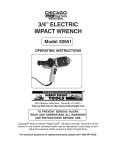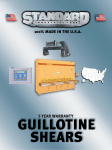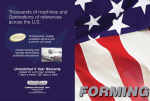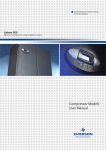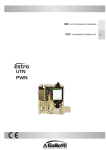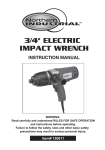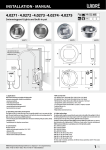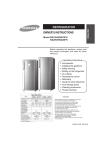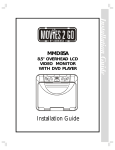Download Chicago Electric 91482 User's Manual
Transcript
10” TILE SAW 24” DEEP CUT - 2.5 HP Model 91482 ASSEMBLY AND OPERATING INSTRUCTIONS ® 3491 Mission Oaks Blvd., Camarillo, CA 93011 Visit our Web site at: http://www.harborfreight.com Copyright© 2004 by Harbor Freight Tools®. All rights reserved. No portion of this manual or any artwork contained herein may be reproduced in any shape or form without the express written consent of Harbor Freight Tools. For technical questions or replacement parts, please call 1-800-444-3353. PRODUCT SPECIFICATIONS Item Electrical Requirements Motor Blade Speed Product Compatibility Cutting Capacity Saw Blade (not included) Requirements Drive Type Angle Cutting Capacity Water Pump Capacity Overall Dimensions Weight Description 120 V / 60 Hz / 1800 W / Single Phase 20 AMP Circuit Breaker 15 Amps 3-Prong, Grounded Power Cord Plug 2.5 HP / 3,450 RPM 3,400 RPM For use with SKU 91483 Stand (not included). 24” Rip Length / 16” Diagonal / 3-3/4” Maximum Depth 10” Continuous Rim, Diamond w/ 5/8” Round Arbor Hole *Must Be Rated At 3,500 RPM Or Greater. Belt Drive / Size A660. 45° Left & Right Miter Block / 45° Right Bevel Block. 3.17 Gallons Per Minute. 41” L x 21” W x 20-1/2” H. 113 Pounds. E221466 SAVE THIS MANUAL You will need this manual for the safety warnings and precautions, assembly, operating, inspection, maintenance and cleaning procedures, parts list and assembly diagram. Keep your invoice with this manual. Write the invoice number on the inside of the front cover. Keep this manual and invoice in a safe and dry place for future reference. UNPACKING When unpacking, check to make sure all the parts shown on the Parts List on page 18 are included. If any parts are missing or broken, please call Harbor Freight Tools at the number shown on the cover of this manual as soon as possible. GENERAL SAFETY RULES WARNING! READ AND UNDERSTAND ALL INSTRUCTIONS Failure to follow all instructions listed below may result in electric shock, fire, and/or serious injury. SAVE THESE INSTRUCTIONS SKU 91482 For technical questions, please call 1-800-444-3353. REV 04/05 Page 2 WORK AREA 1. Keep your work area clean and well lit. Cluttered and dark work areas invite accidents. 2. Do not operate power tools in explosive atmospheres, such as in the presence of flammable liquids, gases, or dust. Power tools create sparks which may ignite the dust or fumes. 3. Keep bystanders, children, and visitors away while operating a power tool. Distractions can cause you to lose control. ELECTRICAL SAFETY 1. Grounded tools must be plugged into an outlet properly installed and grounded in accordance with all codes and ordinances. Never remove the grounding prong or modify the plug in any way. Do not use any adapter plugs. Check with a qualified electrician if you are in doubt as to whether the outlet is properly grounded. If the tool should electrically malfunction or break down, grounding provides a low resistance path to carry electricity away from the user. 2. Avoid body contact with grounded surfaces such as pipes, radiators, ranges, and refrigerators. There is an increased risk of electric shock if your body is grounded. 3. Do not expose unprotected areas to rain or wet conditions. Water entering a power tool will increase the risk of electric shock. 4. Do not abuse the Power Cord. Never use the Power Cord to carry the tools or pull the Plug from an outlet. Keep the Power Cord away from heat, oil, sharp edges, or moving parts. Replace damaged Power Cords immediately. Damaged Power Cords increase the risk of electric shock. 5. When operating a power tool outside, use an outdoor extension cord marked “W-A” or “W”. These extension cords are rated for outdoor use, and reduce the risk of electric shock. PERSONAL SAFETY 1. Stay alert. Watch what you are doing, and use common sense when operating a power tool. Do not use a power tool while tired or under the influence of drugs, alcohol, or medication. A moment of inattention while operating power tools may result in serious personal injury. SKU 91482 For technical questions, please call 1-800-444-3353. Page 3 2. Dress properly. Do not wear loose clothing or jewelry. Contain long hair. Keep your hair, clothing, and gloves away from moving parts. Loose clothes, jewelry, or long hair can be caught in moving parts. 3. Avoid accidental starting. Be sure the Power Switch is off before plugging in. Carrying power tools with your finger on the Power Switch, or plugging in power tools with the Power Switch on, invites accidents. 4. Remove adjusting keys or wrenches before turning the power tool on. A wrench or a key that is left attached to a rotating part of the power tool may result in personal injury. 5. Do not overreach. Keep proper footing and balance at all times. Proper footing and balance enables better control of the power tool in unexpected situations. 6. Use safety equipment. Always wear eye protection. Non-skid safety shoes, hard hat, or hearing protection must be used for appropriate conditions. TOOL USE AND CARE 1. Use clamps (not included) or other practical ways to secure and support a smaller workpiece to the Main Table (99). Holding the work by hand or against your body is unstable and may lead to loss of control. 2. Do not force the tool. Use the correct tool for your application. The correct tool will do the job better and safer at the rate for which it is designed. 3. Do not use the power tool if the Power Switch does not turn it on or off. Any tool that cannot be controlled with the Power Switch is dangerous and must be replaced. 4. Disconnect the Power Cord Plug from the power source before making any adjustments, changing accessories, or storing the tool. Such preventive safety measures reduce the risk of starting the tool accidentally. 5. Store idle tools out of reach of children and other untrained persons. Tools are dangerous in the hands of untrained users. 6. Maintain tools with care. Keep tools clean. Properly maintained tools are easier to control. Do not use a damaged tool. Tag damaged tools “Do not use” until repaired. SKU 91482 For technical questions, please call 1-800-444-3353. Page 4 7. Check for misalignment or binding of moving parts, breakage of parts, and any other condition that may affect the tool’s operation. If damaged, have the tool serviced before using. Many accidents are caused by poorly maintained tools. 8. Use only accessories that are recommended by the manufacturer for your model. Accessories that may be suitable for one tool may become hazardous when used on another tool. SERVICE 1. Tool service must be performed only by qualified repair personnel. Service or maintenance performed by unqualified personnel could result in a risk of injury. 2. When servicing a tool, use only identical replacement parts. Follow instructions in the “Inspection, Maintenance, And Cleaning” section of this manual. Use of unauthorized parts or failure to follow maintenance instructions may create a risk of electric shock or injury. GROUNDING WARNING! Improperly connecting the grounding wire can result in the risk of electric shock. Check with a qualified electrician if you are in doubt as to whether the outlet is properly grounded. Do not modify the power cord plug provided with the tool. Never remove the grounding prong from the plug. Do not use the tool if the power cord or plug is damaged. If damaged, have it repaired by a service facility before use. If the plug will not fit the outlet, have a proper outlet installed by a qualified electrician. GROUNDED TOOLS: TOOLS WITH THREE PRONG PLUGS 1. Tools marked with “Grounding Required” have a three wire cord and three prong grounding plug. The plug must be connected to a properly grounded outlet. If the tool should electrically malfunction or break down, grounding provides a low resistance path to carry electricity away from the user, reducing the risk of electric shock. (See Figure A, next page.) SKU 91482 For technical questions, please call 1-800-444-3353. Page 5 2. The grounding prong in the plug is connected through the green wire inside the cord to the grounding system in the tool. The green wire in the cord must be the only wire connected to the tool’s grounding system and must never be attached to an electrically “live” terminal. (See Figure A.) 3. Your tool must be plugged into an appropriate outlet, properly installed and grounded in accordance with all codes and ordinances. The plug and outlet should look like that in the following illustration. (See Figure A.) 3-PRONG PLUG ELECTRICAL OUTLET FIGURE A EXTENSION CORDS 1. Grounded tools require a three wire extension cord. 2. As the distance from the supply outlet increases, you must use a heavier gauge extension cord. Using extension cords with inadequately sized wire causes a serious drop in voltage, resulting in loss of power and possible tool damage. (See Figure B, next page.) 3. The smaller the gauge number of the wire, the greater the capacity of the cord. For example, a 14 gauge cord can carry a higher current than a 16 gauge cord. (See Figure B.) 4. When using more than one extension cord to make up the total length, make sure each cord contains at least the minimum wire size required. (See Figure B.) 5. If you are using one extension cord for more than one tool, add the nameplate amperes and use the sum to determine the required minimum cord size. (See Figure B.) SKU 91482 For technical questions, please call 1-800-444-3353. Page 6 6. If you are using an extension cord outdoors, make sure it is marked with the suffix “W-A” (“W” in Canada) to indicate it is acceptable for outdoor use. 7. Make sure your extension cord is properly wired and in good electrical condition. Always replace a damaged extension cord or have it repaired by a qualified electrician before using it. Protect your extension cords from sharp objects, excessive heat, and damp or wet areas. RECOMMENDED MINIMUM WIRE GAUGE FOR EXTENSION CORDS* (120 VOLT) NAMEPLATE AMPERES (At Full Load) 0 – 2.0 2.1 – 3.4 3.5 – 5.0 5.1 – 7.0 7.1 – 12.0 12.1 – 16.0 16.1 – 20.0 EXTENSION CORD LENGTH 25 50 75 Feet Feet Feet 18 18 18 18 18 18 18 18 16 18 16 14 18 14 12 14 12 10 12 10 * Based on limiting the line voltage drop to five volts at 150% of the rated amperes. 100 Feet 18 16 14 12 10 - 150 Feet 16 14 12 12 - FIGURE B SYMBOLOGY Double Insulated Canadian Standards Association Underwriters Laboratories, Inc. V~ A no xxxx/min. Volts Alternating Current Amperes No Load Revolutions per Minute (RPM) FIGURE C SKU 91482 For technical questions, please call 1-800-444-3353. Page 7 SPECIFIC SAFETY RULES 1. Maintain a safe working environment. Keep the work area well lit. Make sure there is adequate surrounding workspace. Always keep the work area free of obstructions, grease, oil, trash, and other debris. Do not use the Tile Saw in areas near flammable chemicals, dusts, and vapors. 2. Maintain labels and nameplates on the Tile Saw. These carry important information. If unreadable or missing, contact Harbor Freight Tools for a replacement. 3. Use the right product for the right job. There are certain applications for which this product was designed. Do not use small equipment, tools, or attachments to do the work of larger industrial equipment, tools, or attachments. Do not use this product for a purpose for which it was not intended. 4. This product must continuously run with cold water. Dry running will cause serious damage to the Pump seals. 5. CAUTION! Keeps hands and fingers away from cutting area and Saw Blade. Use an appropriate “push stick” (not included) when necessary. 6. Check Blade Guard for proper upward/downward movement before each use. Do not operate the Tile Saw if the Blade Guard does not move freely. Never clamp or tie the Blade Guard into the upper position. If the Tile Saw is accidently dropped the Blade Guard may be bent. Raise the Blade Guard and make sure it moves freely and does not touch the Saw Blade or any other part of the Saw, in all angles and depths of cut. 7. Do not pull or carry the Tile Saw by its Power Cord or pull the Cord around sharp corners or edges. Do not unplug the Tile Saw by pulling on the Cord. Keep the Cord away from heated surfaces. 8. Keep all guards in place and in proper working order. 9. Do not handle the Power Switch with wet hands. 10. Make sure the Tile Saw is mounted on a flat, level, sturdy work surface capable of supporting the weight of the Saw and workpieces. 11. Always use Continuous Rim, Diamond Saw Blades with a 10” diameter, 5/8” round arbor hole, and rated at 3,500 RPM or greater. Saw Blades that do not match the mounting hardware of the Tile Saw or that are rated less than the required minimum RPM will run eccentrically causing loss of control or may fly off the Saw. 12. Use the Tile Saw only for cutting ceramic tile, quarry tile, marble, terra cotta, and slate with a maximum thickness of 3”. SKU 91482 For technical questions, please call 1-800-444-3353. Page 8 13. Do not use the Tile Saw for cutting metals or for cutting curves. This may cause the Saw Blade to break and/or reduce its service life. 14. Make sure the Saw Blade is wet at all times when cutting. 15. Keep all electrical connections dry and off the ground. 16. Use cold water only. Never use hot water. Using hot water can damage the Pump seals. 17. Never run the Tile Saw without a water supply. Running the unit without a water supply will cause irreparable damage to the Pump, Motor, or Blade. 18. Make sure the water supply used for the Tile Saw is not dirty, sandy, and does not contain any corrosive chemical products. Always add fresh, clean water before using the unit. 19. Never leave the Tile Saw unattended when it is plugged into an electrical outlet. Turn off the Tile Saw, and unplug it from its electrical outlet after use. 20. Always keep the water level at the recommended level. Fill the Tank with enough water so that the Pump’s inlet is completely submerged, but not so much water that the Tank overflows. 21. Never splash water on the Motor, Power Switch, Power Cord, or any other electrical component. Make sure to stand on a dry, insulated surface such as a rubber mat while using the Tile Saw. 22. Make sure to clean the Tank thoroughly after each use. 23. To avoid accidental injury, always wear heavy duty work gloves when changing the Saw Blade. 24. Before using the Tile Saw, make sure the Saw Blade is properly mounted on the Saw Spindle. Make sure the Saw Blade is balanced, and is not cracked or bent. 25. The Saw Blade may become hot while cutting. Allow the Saw Blade to completely cool before handling. 26. Allow the Saw Blade to spin up to full speed before feeding a workpiece into it. When turning off the Tile Saw, allow the Saw Blade to spin down and stop on its own. Do not press against the Saw Blade to stop it. 27. Do not force the workpiece into the Saw Blade when cutting. Apply moderate pressure, allowing the Saw Blade to cut without being forced. SKU 91482 For technical questions, please call 1-800-444-3353. Page 9 28. Turn off the Tile Saw and allow the Saw Blade to stop on its own if the Saw Blade is to be backed out of an uncompleted cut. 29. Never attempt to remove material stuck in the Tile Saw while it is plugged in or running. 30. When cutting a large workpiece make sure its entire length is properly supported. 31. Never stand on the Tile Saw. Serious injury can result if the Tile Saw is tipped or if the rotating Saw Blade is accidently contacted. 32. Industrial applications must follow OSHA requirements. 33. For your safety: In extreme working conditions the Circuit Breaker will automatically switch off the Motor to prevent overheating. In this event, turn the Power Switch to its “OFF” position. Wait five minutes or until the Motor has cooled. Depress the Circuit Breaker. Then, turn the Power Switch to its “ON” position to resume cutting. If the Circuit Breaker continues to trip, have the tool serviced by a qualified technician. NEVER attempt to disable the Circuit Breaker. 34. Always turn off the Tile Saw, unplug it from its electrical outlet, and allow it to stop before changing accessories or performing any inspection, maintenance, or cleaning procedures. 35. WARNING! Some dust created by power sanding, sawing, grinding, drill ing, and other construction activities, contain chemicals known (to the State of California) to cause cancer, birth defects or other reproductive harm. Some examples of these chemicals are: lead from lead-based paints, crystalline silica from bricks and cement and other masonry products, arsenic and chromium from chemically treated lumber. Your risk from these exposures varies, depending on how often you do this type of work. To reduce your exposure to these chemicals: work in well ventilated areas, and work with approved safety equipment such as those dust masks that are specially designed to filter out microscopic particles. (California Health & Safety Code 25249.5, et seq.) 36. WARNING! People with pacemakers should consult their physician(s) before using this product. Operation of electrical equipment in close proximity to a heart pacemaker could cause interference or failure of the pacemaker. 37. WARNING! The warnings and cautions discussed in this manual cannot cover all possible conditions and situations that may occur. It must be understood by the operator that common sense and caution are factors which cannot be built into this product, but must be supplied by the operator. SKU 91482 For technical questions, please call 1-800-444-3353. Page 10 ASSEMBLY INSTRUCTIONS NOTE: For additional information regarding the parts listed in the following pages, refer to the Assembly Diagram on page 19. 1. WARNING! Always make sure the Power Switch of the Tile Saw is in its “OFF” position and the unit is unplugged from its electrical outlet prior to assembling the unit, adding any accessories, or making any adjustments to the unit. 2. Mount the Tile Saw to the machine frame by connecting the Aluminum Base (38) to the Aluminum Column (35), using the Shaft (36), Position Tube (57), Bolt (30), Large Washer (32), Bolt (59), and Washer (58). (See Figure D.) 3. Tighten the Knob (31) to hold the Tile Saw in position. (See Figure D.) REAR VIEW BELT TENSION BOLT (41) KNOB (31) BOLT (30) LARGE WASHER (32) BOLT (59) WASHER (58) SHAFT (36) ALUMINUM BASE (38) FIGURE D 4. ALUMINUM COLUMN (35) POSITION TUBE (57) At this time remove the Bolts (76) that hold the Pulley Cover (75) on, remove the Cover, and check that the Belt (74) is tight and in good condition. It should deflect (move) a little (about 1/2” deflection) when pressed with the thumb. If the Belt is loose, do the following: a. Loosen all 4 Nuts (46) that hold down the Motor (45). b. Gradually tighten the Belt Tension Bolt (41), all the while checking the tension on the Belt - see Figure D. Tighten the Belt to about 1/2” deflection. Do not overtighten; overtightening can cause damage to the bearings in the Motor. c. Retighten all 4 Nuts (46). d. Reinstall the Pulley Cover (75) using the Bolts (76). 5. Slide the Water Tank (3) through the slot in the Machine Frame (11) and under the Aluminum Bar (83), so that the entire Water Tank rests inside the Machine Frame. (See Figure E, next page.) SKU 91482 For technical questions, please call 1-800-444-3353. Page 11 WATER TANK (3) MACHINE FRAME (11) FIGURE E PUMP POWER CORD ELECTRICAL RECEPTACLE WATER HOSE (PRE-ATTACHED) PUMP (105) (PLACE PUMP IN REAR OF WATER TANK) FIGURE F 6. Plug the Power Cord of the Pump (105) into the electrical receptacle located on the back of the Motor. Then, set the Pump (105) in the rear of the Water Tank (3), using the four suction feet on the bottom of the Pump. (See Figure F.) 7. Attach the Extension Table (94) to the Main Table (99), using the four Bolts (93). (See Figure G.) 8. If desired, this saw can be mounted to a Stand (ITEM 91483, not included). See the manual included with the stand for installation instructions. FIGURE G MAIN TABLE (99) EXTENSION TABLE (94) BOLT (93) SKU 91482 For technical questions, please call 1-800-444-3353. Page 12 CHANGING OR INSTALLING A SAW BLADE 1. WARNING! Always make sure the Power Switch of the Tile Saw is in its “OFF” position and the unit is unplugged from its electrical outlet prior to assembling the unit, adding any accessories, or making any adjustments to the unit. 2. Loosen the Knob (53) located on the side of the Blade Guard (60) and raise the Blade Guard. (See Figure H.) Then, retighten the Knob to lock the Blade Guard in the “up” position. BLADE GUARD (60) (DOWN POSITION) KNOB (53) FIGURE H 3. Depress the Brake Shaft (68) while turning the Saw Blade (65) (or Spindle (80) if you have not yet installed a Saw Blade) until the Brake Shaft (68) depresses fully. This will prevent the Spindle from spinning. (See Figure I, next page.) 4. Using the accessory Wrench, unscrew the Nut (67) counterclockwise and remove it and the Outer Flange (66). (See Figure J, next page.) 5. Using heavy duty gloves to avoid accidental cuts, remove the old Saw Blade (65) and install a new Saw Blade. Always use Continuous Rim, Diamond Saw Blades with a 10” diameter, 5/8” round arbor hole, and rated at 3,500 RPM or greater. (See Figure K, next page.) 6. NOTE: When installing a Saw Blade (65), make sure the “ARROW” depicted on the upper side of the Saw Blade points to the front of the Tile Saw. (See Figure K.) SKU 91482 For technical questions, please call 1-800-444-3353. Page 13 7. Refasten the Outer Flange (66) and Nut (67). Make sure to tighten the Nut fully before using the Tile Saw. (See Figure J.) 8. Loosen the Knob (53). Lower the Blade Guard (60) fully. Then, retighten the Knob to lock the Blade Guard in position. (See Figure L.)] FIGURE I BRAKE SHAFT (68) FIGURE J NUT (67) OUTER FLANGE (66) WRENCH FIGURE K ROTATION ARROW FIGURE L BLADE GUARD (60) KNOB (53) SAW BLADE (65) SKU 91482 For technical questions, please call 1-800-444-3353. Page 14 OPERATING INSTRUCTIONS 1. Place the Saw (or saw and stand, if the optional stand is installed) on a level, even surface, capable of supporting the tool and any forces exerted during work. Fill the Water Tank (3) with enough cold water so that the Pump (105) is completely submerged, but not so much water that the Water Tank overflows. NOTE: To prevent excessive wear on the Saw Blade (65), make sure to maintain a continuous flow of water over the entire Saw Blade while cutting. Never cut anything if the water flow is not continuous. 2. To attach the Parallel Guide (84), loosen the Knob (86) on the side of the Guide. Place the hooked portion of the Guide over the upturned edge of the Main Table (99). Slide the Guide horizontally to the right or left until the desired width of cut is obtained (allowing space for grout). Then, tighten the Knob to lock the Guide in position. (See Figure M.) FIGURE M PARALLEL GUIDE (84) MAIN TABLE (99) 3. KNOB (86) Attach the Angle Block (85) as you did the Parallel Guide, using the two Knobs (86) on the side of the Guide. Use the cutting groove in the middle of the Main Table to brace the edge of the tile as the tile is slid underneath the Saw Blade (65). (See Figure N.) ANGLE BLOCK (85) KNOB (86) FIGURE N SKU 91482 For technical questions, please call 1-800-444-3353. Page 15 4. Attach the 45° Miter Block (108) as you did the Parallel Guide, using the Knob (86) on the side of the Guide. (See Figure O.) POWER SWITCH CIRCUIT BREAKER 45° MITER BLOCK (108) FIGURE O KNOB (86) 5. Plug the Power Cord of the Tile Saw into the nearest, 120 volt, grounded, electrical outlet. 6. Make sure to wear an ANSI approved safety impact full face shield over ANSI approved safety glasses and a dust mask when cutting tile. At all times, keep hands and fingers away from the spinning Saw Blade (65). 7. Place the marked tile on the Main Table (99) and brace it against the Guide you have chosen to use. Then, align the cut mark with the Saw Blade (65). 8. Turn the Flow Control Lever (105D) all the way down. Turn the Power Switch to its “ON” position, and allow the Saw Blade (65) to spin up to full speed. Adjust the Flow Control on the Pump until the water reaches the edge of the Blade just before the Blade would contact the material being cut. Make sure the Pump (105) is supplying a continuous flow of water to the entire Saw Blade. (See Figure O.) 9. Make sure the Blade Guard (60) is in place and in proper working order. Hold the tile firmly against the Guide with one hand. With the other hand, move the Main Table (99) and tile slowly underneath the Saw Blade (65). 10. Continue moving the Main Table (99) and tile underneath the Saw Blade (65) until the cut is completed. 11. Once the cut is completed turn the Power Switch to its “OFF” position, and allow the Saw Blade (65) to stop on its own. Then remove the cut tile and debris from the Main Table (99), and unplug the Power Cord from the electrical outlet. 12. NOTE: If the Motor (45) stops suddenly while cutting, turn the Power Switch to its “OFF” position. Wait approximately 5 minutes. Then reset the Circuit Breaker to resume cutting. (See Figure O.) SKU 91482 For technical questions, please call 1-800-444-3353. Page 16 INSPECTION, MAINTENANCE, AND CLEANING 1. WARNING! Make sure the Power Switch of the Tile Saw is in its “OFF” position and that the unit is unplugged from its electrical outlet before performing any inspection, maintenance, or cleaning procedures. 2. Before each use, inspect the general condition of the Tile Saw. Check for loose screws, misalignment or binding of moving parts, damaged electrical wiring, damaged Hose, and any other condition that may affect its safe operation. If abnormal noise or vibration occurs, have the problem corrected before further use. Do not use damaged equipment. 3. Before each use, inspect the Diamond Saw Blade. Using a dull Saw Blade will cause excessive wear on the Motor, and will not produce a satisfactory cut. Replace with a new Saw Blade when needed. 4. Before each use, inspect the mounting Screws on all Safety Covers and the Arbor Nut on the Saw Blade Shaft. If necessary, retighten all loose Screws and Nuts. 5. NOTE: The Pump is non-serviceable. If the Pump should fail, first try clearing the intake of debris and make sure the hole is not plugged. If the Pump still does not operate properly, it must be replaced. 6. To clean the exterior parts: Use only a clean cloth and mild detergent to clean the body of the Tile Saw. Do not use solvents. Do not immerse any electrical part of the tool in liquid. 7. When storing, always completely empty the Tile Saw of water. Frost will damage the Pump if the unit contains water. Store the Tile Saw indoors in a dry, frost-free room. 8. Periodically, remove the Pulley Cover (75) as explained under Assembly Instruction 4 on page 11 and check the condition and tightness of the Belt (74). If the belt appears damaged (frayed, cracked, or partially broken) or is broken, loosening the 4 Nuts (46) and the Belt Tension Bolt (41), replace the Belt (74) and retighten it as explained on page 11. PLEASE READ THE FOLLOWING CAREFULLY THE MANUFACTURER AND/OR DISTRIBUTOR HAS PROVIDED THE PARTS LIST AND ASSEMBLY DIAGRAM IN THIS MANUAL AS A REFERENCE TOOL ONLY. NEITHER THE MANUFACTURER OR DISTRIBUTOR MAKES ANY REPRESENTATION OR WARRANTY OF ANY KIND TO THE BUYER THAT HE OR SHE IS QUALIFIED TO MAKE ANY REPAIRS TO THE PRODUCT, OR THAT HE OR SHE IS QUALIFIED TO REPLACE ANY PARTS OF THE PRODUCT. IN FACT, THE MANUFACTURER AND/OR DISTRIBUTOR EXPRESSLY STATES THAT ALL REPAIRS AND PARTS REPLACEMENTS SHOULD BE UNDERTAKEN BY CERTIFIED AND LICENSED TECHNICIANS, AND NOT BY THE BUYER. THE BUYER ASSUMES ALL RISK AND LIABILITY ARISING OUT OF HIS OR HER REPAIRS TO THE ORIGINAL PRODUCT OR REPLACEMENT PARTS THERETO, OR ARISING OUT OF HIS OR HER INSTALLATION OF REPLACEMENT PARTS THERETO. SKU 91482 For technical questions, please call 1-800-444-3353. Page 17 PARTS LIST P art # 1 2 3 4 5 6 7 8 9 10 11 12 13 14 15 16 17 18 27 28 29 30 31 32 33 34 35 36 37 38 39 40 41 42 43 44 45 46 47 48 49 50 51 52 53 54 55 56 57 58 59 60 SKU 91482 D e s c r ip t io n W asher Nut W a te r T a n k E la s tic W a s h e r B o lt R u b b e r In s e rt A lu m in u m G u id e P la s tic In s e rt P re s s in g P la te S c re w M a c h in e F ra m e Nut B o lt B o lt E la s tic W a s h e r W asher A d ju s tin g P la te C a rry in g H a n d le P la s tic In s e rt B o lt B o lt B o lt K nob L a rg e W a s h e r P o s itio n T u b e W asher A lu m in u m C o lu m n S h a ft C o a c h B o lt A lu m in u m B a s e M o to r A d ju s tin g B a r L a rg e W a s h e r B e lt T e n s io n B o lt M o to r P u lle y S c re w K ey M o to r Nut E la s tic W a s h e r W asher S c re w T h re e -W a y T u b e R u b b e r P la te W asher K nob S c re w C o n n e c tin g P la te S m a ll S h a ft P o s itio n T u b e W asher B o lt B la d e G u a rd Q ty . 4 2 1 4 2 1 1 2 2 4 1 4 2 2 2 2 2 2 1 2 1 1 1 1 1 1 1 1 4 1 1 1 1 2 2 2 1 4 4 4 1 1 1 1 1 1 1 1 1 1 1 1 P art # 61 62 63 64 65 66 67 68 69 70 71 72 73 74 75 76 77 78 79 80 81 82 83 84 85 86 87 88 89 90 91 92 93 94 95 96 97 98 99 100 101 102 103 104 105 105A 105B 105C 105D 106 107 108 D e s c rip tio n S c re w R ubber P ad B e a rin g In n e r F la n g e S a w B la d e (n o t in c lu d e d ) O u te r F la n g e Nut B ra k e S h a ft S c re w B ra k e H o ld e r R e ta in in g R in g S p rin g W asher B e lt P u lle y C o v e r B o lt P o s itio n P la te B o lt S p in d le P u lle y S p in d le S p in d le S le e v e S lid in g G u id e A lu m in u m B a r P a ra lle l G u id e A n g le B lo c k K nob B o lt R o llin g W h e e l B o lt S te e l P la te F ro n t T a b le B o lt B o lt E x te n s io n T a b le Nut B o lt E la s tic W a s h e r W asher M a in T a b le L in e a r B e a rin g R e ta in in g R in g S te e l In s e rt N y lo n In s e rt S lid in g T u b e P um p P um p B ody Im p e lle r C ove r F lo w C o n tro l L e v e r R ubber P ad W a te r S u p p ly S y s te m 4 5 ° M ite r B lo c k For technical questions, please call 1-800-444-3353. Q ty . 3 1 2 1 1 1 1 1 2 1 1 1 3 1 1 2 1 3 1 1 1 1 1 1 1 4 1 1 1 1 1 2 4 1 2 2 2 2 1 2 2 2 2 1 1 1 1 1 1 1 1 1 Page 18 ASSEMBLY DIAGRAM 105A 105B 105D 105C NOTE: Some parts are listed and shown for illustration purposes only, and are not available individually as replacement parts. SKU 91482 For technical questions, please call 1-800-444-3353. Page 19



















